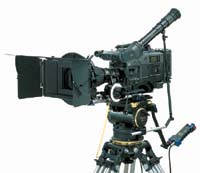The Final ShowDown
Back to Contents of Issue: May 2002
|
|
|
|
by John Cairns & Ryan Skelton |
|
 I'M GOING TO BE using digital technologies a lot more in my next project," an amiable Macoto Tezka says of his new thriller. Tezka is a Japanese director (he calls himself a 'visualist') who has readily used new media in his work, dating back to the 1970s when he belonged to a flourishing 8 mm film stock movement. And now Tezka is very much out in front of the very real move toward digital technology. I'M GOING TO BE using digital technologies a lot more in my next project," an amiable Macoto Tezka says of his new thriller. Tezka is a Japanese director (he calls himself a 'visualist') who has readily used new media in his work, dating back to the 1970s when he belonged to a flourishing 8 mm film stock movement. And now Tezka is very much out in front of the very real move toward digital technology.
The reason digital's time has come is simple, he says. "The audience can't make the distinction between digital and non-digital shots any more, so I can use digital really effectively. Because the technology used in digital cameras has improved so greatly, I may even use digital recording cameras to shoot the effects scenes in my next project," says the 41-year-old director whose last feature, Hakuchi, was artfully filled with beautiful but costly effects. It's hard to think of a business that will be more wholly affected by technological progress than the film industry. The arrival of digital in the visual media sphere signals an almost total overhaul for both the business and creative sides. Digital has been leaking into all aspects of the filmmaking process for years and has finally reached the point where it permeates every level of production. Some companies, such as Sony and Matsushita, stand to gain greatly from its realization, but others, like Kodak and Japanese production studios Toei, Toho and Shochiku, are being forced against the ropes. This is no small event: Digital technology is destined to change not only the business of moviemaking, but also what kind of movies will get made. It is bringing about a transformation tantamount to a complete horizontal and vertical restructuring of the film world. The filmmaking and marketing process has eight basic stages from conception to delivery: A concept is developed, a script is written, then there is pre-production, production, post-production, marketing, theatrical release and finally the marketing of consumer durables such as videos, DVDs and tie-ins. Digital technology is having strong impact on all eight stages and Japan has a critical role to play, particularly in the digital production and consumer durable arenas. On the production side, Panasonic (Matsushita) and Sony are leaders in digital camera technology and will dictate the shape of production technology to come. Cinema holds special significance for these industry leaders because the production technology and marketing distribution aspects of the business are tacitly interrelated. Sony is at the forefront of digital camera technology with its Cinealta 24p, a high definition (HD) progressive scanning device. Progressive scanning is significant because the entire image is captured in one shot, as with film. Until now digital video has been interlaced, weaving two separate images together that are captured at different moments. The resulting increase in picture quality is making waves throughout the film industry. "The original driving force behind the development of HD24p was the cost of post-production," says Takashi Hayasaka, senior manager for business promotion at Sony. "US film and television companies presently have around five different production standards, which makes post-production unnecessarily difficult." Produce in digital and a variety of barriers to product dissemination are lifted. Sony cameras are commonly used with Matsushita lenses, for example. Also, a film can be shot in digital and edited in digital, eliminating the costly conversion process. Then it could be recorded onto DVD for sale and rental without conversion -- the visual information of an entire movie would take up 12 DVDs, but the product we see at home has had information painstakingly reduced from the original film stock image. Ultimately, widespread digital projection at cinemas may be feasible. The acceptance of a new production standard is potentially a great boon to both Sony and Matsushita. But there will not be a single new standard; instead standards will emerge across the broad spectrum of equipment necessitated by digital cinema, incorporating digital editing suites, monitors, sound recording equipment, cinema projectors and DVD processing equipment. Digitization of the industry will cause all production studios to rethink their business and distribution approaches. Matsushita passed Universal Pictures onto Seagram in the mid 1990s (it's now with French company Vivendi), but Sony has the Columbia Tristar studio. "With the opening of alternate distribution channels, distributors may find themselves squeezed out of the picture all together," says Sony's Hayasaka. "Movie theaters could find revenues eroded by alternative viewing options." Sony has been through this sort of thing before with the DAT system. Its high-quality recording capability threatened to be a major thorn in the side of the music industry, which boycotted the release of titles on the format. This is the double-bind of corporations which hope to develop innovative technologies: Their successes often bite into the profits of other divisions. 
Digital technology has been teaching us since its inception that market mechanisms cannot hope to keep up with the rate of technological advancement. However, the time looks right for digital technology -- Japan may have achieved just the right blend of complementary technologies to move us forward with only restructuring, rather than total upheaval. Japanese films stand to benefit immediately from increased overseas exposure if high definition technology lives up to its reputation among supporters. "At the Berlin festival the cost of using film stock makes Japanese films rather an unattractive purchase," says Naokatsu Itoh, a Japanese film producer and festival stalwart. "What you can do on film in Europe for JPY200,000 costs JPY1 million to do in Japan." Itoh, who has had two films in competition in Berlin, has difficulty selling his works at festival markets due to high domestic film stock costs. High definition technology would take this disadvantage and turn it on its head. Japanese films could be cost competitive within a few years. Tokyo-based Icelandic filmmaker Gisli Snaer Erlingsson is excited that pitfalls he believed existed may have been exaggerated. "In Berlin I just saw a film that was shot on high definition and it was absolutely gorgeous. The colors were vibrant and the blacks were absolutely beautiful," he says. "There were three or four shots where you could see a sort of interlaced effect. But, I asked some questions and that appears to have been a mistake by the cameraman." Freedom from the shackles of high film costs may also have broad-ranging effects on what we see. Hayasaka believes that the positive side of fewer distribution controls "will result in content owners gaining greater control and influence, possibly serving as an inducement to content creation." This doesn't imply a broader range of inventive content, just less top-down control and more liberty to deal with greater subject matter. A bottom-up production model, in which creators have most of the control, may result in more profitable content creation. Digital film technology has come of age. The technology has had enough time and money invested in it to make it viable. But where does that leave film stock producers, such as Kodak and to a lesser extent, Fuji, which have been diversifying into digital technology? George Lucas boasts that "we have programs that can make [digital] look like Kodak or Fuji. We're even starting now to break down the numbers so that you can make it look exactly like a particular stock." A director must choose the cheapest way to achieve the feel that best suits their work. Until recently, the range of high definition technology was severely limited. Now there is enough scope to challenge film stock. Soon there will be more. Rick McCallum, producer on Lucas's upcoming Star Wars Episode II: Attack of the Clones, estimates the use of digital "saved about $1.6 million in stock, dailies, sound transfers, lab and telecine (the transfer of film to other media, such as tape) costs and we saved even more by not having to put the film into a computer." Digital is not just for special effects films. The cost-saving effects of Digital HD CAM equipment alone is remarkable. High definition is only the tip of the digital iceberg. Film distributors are having all manner of doors opened to them, including some that require caution and prudent judgment. US-based Intertainer has found a way to ready itself for Internet-literate movie watchers by steadily acquiring rights to films for high-speed Internet and cable distribution on a pay-per-view basis. This includes many productions by Universal Pictures, Warner Bros., Dreamworks SKG, Artisan and MGM. Yet, in a business sense, Internet film distribution is still seen as a complement to, rather than an actual replacement of the cinema. Japan now possesses the broadband capacity to move into Net film distribution, but without a convincing precedent abroad, it is unlikely to dive in headfirst. After all, despite Japan being at the forefront of product development, the Japanese themselves are notoriously late adopters of technology. "You'll be able to download and watch a film quite easily by the second half of this year, though I don't think many people will be interested in watching a PC screen for two hours," Itoh says. "Net distribution won't be effective until the computer screen is replaced by a larger scale monitor, a plasma screen, for instance." Matsushita is developing an IP (Internet protocol) television for release early next year that has this simplicity of use in mind. IP TV ,though, is likely going to be immediately geared for use with terrestrial digital TV and broadcast satellite (BS) digital TV, both of which Matsushita has stakes in. 
Director Tezka, who is the son of the famous manga artist Osamu Tezuka, sees some downsides to electronic distribution, saying the collective emotion of the theater audience is the most valuable reward for his artistry. "As a filmmaker, I take great pleasure in seeing the reaction of audiences to my films," he says. "On the Internet that pleasure is lost. It's also still a little difficult to make a profit with Internet films." Erlingsson is more upbeat about digital possibilities. "Screens and digital projectors are getting better and better. A film only exists because you want it to be shown, so if I could make a film on digital video then print it on DVD and show it in a theater to 50 people, I would definitely do that." The DVD was created by Philips, Sony, Matsushita and Toshiba as an eventual replacement for both the CD and the VHS videocassette. DVD stand-alone players boost the bottom lines of Sony, Pioneer and other manufacturers and, of course, DVDs can be used on computers. However, there is a tendency for new products to appear esoteric. As a result, DVD has been left simmering by the domestic rental market. Certainly sales of the software are booming, but rentals are well behind those in the US. Japan is Hollywood's second largest domestic film market, which is one reason Warner Bros. released The Matrix: Special Edition in Japan alongside the much anticipated PlayStation 2 game console in March 2000. Warners sold 600,000 copies of The Matrix in its first week of release. Tie-ins of this nature are giving DVDs plenty of exposure in Japan, where it was projected that 11.5 percent of the population had a player a year after release. Though rental figures are low, cinephiles in Japan are jumping on the software bandwagon, which is great news for major studios that are propping up their revenues, promoting upcoming sequels and gaining strong revenues from back catalogs. The cost of marketing a theatrical release is approximately twice that of promoting a DVD/VHS release. And there's nothing taken off the back-end of DVD sales, unlike cinemas, which take hefty cuts for screening films. The release of the PS2 in Japan also reminded US movie studios of an old pitfall. Zoning DVD releases prevents their titles from being prematurely released in foreign markets; this is especially key to Japan, where marketing and subtitling typically delay release by several months. The original PS2 came with a utility disk that allowed users to play DVDs from any copyright zone. Sony, threatened by the prospect of litigation from US movie studios, quickly recalled the disks, but only 108,000 of the 1.25 million disks were returned after six months. Japan has an insatiable urge for film, one that necessitates copyright protection, but one that, with the aid of digital technology, looks set to flourish, creating a vibrant range of new domestic films and enhancing opportunities for foreign films. Belying the potential for a healthy Internet-fueled film movement in Japan is the still untamed nature of the Internet itself. The copyright problems brought about by digital media are easy to pinpoint -- digital media dissemination online is simple but difficult to track, and it is even more difficult to ensure royalty collection. Geographical zones offer a hurdle to illegal users of DVDs, and are easy to apply, but DVDs are the most controllable form of digital media. Internet distribution poses the greatest problem to distributors and content creators. Some legal experts, such as Stanford University intellectual property lawyer Lawrence Lessig, argue that looser standards for Internet copyright provide the best answer to the problem, but the US government seems to be favoring big business monopolies, Lessig says. Japan's film industry watches the debate from afar for now. Back home, there are signs of an emerging independent film and video scene in Japan backed by big business. The Santamania Short Film Festival, promoted by Sony and its Sonet Internet provider, is just one showcase for new digital filmmaking talent in the Tokyo area. The response to this festival, staged in February, was overwhelming. The two shows were filled to well over capacity, despite being held from midnight until 6am, and they proved to be an excellent forum for around 10 young Japanese directors to display their abilities. Winners are having films hosted by Sonet for public access. This should be only the beginning of digital film competitions in Japan. "Around 70 percent of film students are now making their projects on digital video exclusively," says producer Itoh. With such a groundswell in digital production at the amateur, student and industry level, the face of film is about to change forever. For Japan this will mean domestic film exports should blossom, and new industry standards will provide at least two of its technology giants with new cash cows. Thanks to Japanese business creativity, digital looks set to enhance the film industry at each and every level of the production process, giving us more of the world's most accessible cultural product, and making it better. Or, as director Erlingsson sees it: "There's a lot of creative young filmmakers in university now who have the opportunity to make a lot of films. The trouble always used to be, you would come out of school with four short films, because they were shot on film. Now if you spend four years in a film school you can come out with 40. The most important thing is to do it again and again. That's when you get closer to mastering the craft." @ |
|
Note: The function "email this page" is currently not supported for this page.





